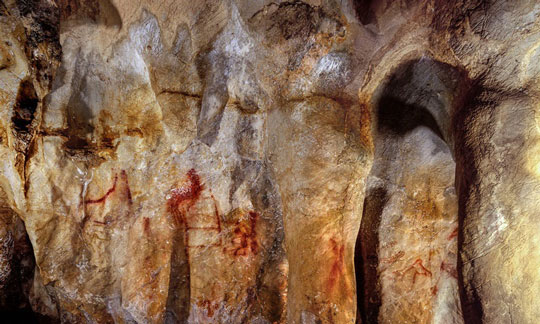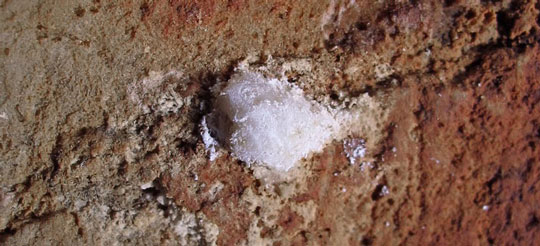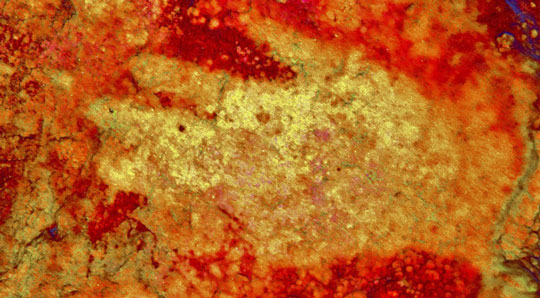Neanderthals Thought Like Us According to New Research
Iberian Neanderthals Created Cave Art
The image of the Neanderthal (Homo neanderthalensis), has changed radically over the last few decades. Gone are the images of a brutish, “ape-man” as depicted by 20th century artists such as Burian and Charles Knight. A lot of evidence has emerged in recent years that supports the idea that Neanderthals, our closest cousins, were as sophisticated as us with a rich and diverse culture.
A new study, published in the journal “Science”, proposes that Iberian Neanderthals, created cave paintings as early as 64,000 years ago and that these paintings were as complex as those associated with our own species. Neanderthal artists used symbolism, geometric shapes and linear signs just as complicated as those drawn by H. sapiens.
Abstract and Symbolic Cave Art Created by Neanderthals

Picture credit: P. Saura
What Does it Mean to be Human?
Defining what it means to be human (Homo sapiens), has just become a little more complicated. It was once thought that our ability to create abstract art, to use symbols and to develop a culture was a defining characteristic that elevated our species above all the other hominins.
Lead author of the new research, Dirk Hoffmann of the Max Planck Institute for Evolutionary Anthropology (Leipzig, Germany) explained:
“The emergence of symbolic material culture represents a fundamental threshold in the evolution of humankind. It is one of the main pillars of what makes us human. Artefacts whose functional value lies not so much in their practical but rather in their symbolic use are proxies for fundamental aspects of human cognition as we know it.”
Homo neanderthalensis Had a Culture Too
Early symbolic artefacts, like pigment-coloured shells that possibly served as body ornamentation, are documented for the Middle Stone Age in North and South Africa. These have been dated to approximately 70,000 years ago (middle Tarantian stage of the Pleistocene Epoch) and are associated with anatomically and behaviourally modern humans. There is evidence in Europe for cave art, sculpted figures, decorated bone tools and jewellery made of bone, tooth, ivory, shell or stone that dates back to the so-called “Upper Palaeolithic Revolution” around 40,000 years ago. These artefacts, researchers concluded, must have been created by modern humans who were spreading all over Europe after their arrival from Africa.
A Shell with Traces of Pigmentation – An Object Dating from at Least 115,000 Years Ago

Picture credit: João Zilhão (Catalan Institution for Research and Advanced Studies
Cave Art Previously Only Associated with Homo sapiens
Cave paintings are a particularly impressive statement of culture and the use of symbolic behaviour. To date, cave art and paintings have only been attributed to modern humans. A lack of precise dating has hindered attempts to prove that Homo neanderthalensis painted on cave walls too. The perpetrators of cave art cannot usually be identified directly, the age of the paintings is the only determinant, providing indirect evidence of who created the paintings based on their geological age. However, a new advanced dating technique has permitted more precise dating and this research suggests that Neanderthals were just as artistic as ourselves.
Post-doctoral researcher Hoffmann added:
“Dating cave art accurately and precisely, but without destroying it, has so far been difficult to accomplish. Thanks to recent technical developments we can now obtain a minimum age for cave art using Uranium-Thorium (U-Th) dating of carbonate crusts overlying the pigments.”
Uranium-Thorium Dating
Uranium-Thorium dating is very precise and it relies on the radioactive decay of uranium isotopes into thorium, this methodology can accurately date calcium carbonate deposits and formations associated with cave art and it can determine the age of calcium carbonate which is up to half a million years old – more than enough scope to chronologically test all forms of cave painting.
Dating Cave Art Using Uranium-Thorium Analysis

Picture credit: João Zilhão (Catalan Institution for Research and Advanced Studies
The international team of researchers, which included scientists from the University of Southampton, analysed more than sixty carbonate samples from three different cave sites in Spain: La Pasiega in north-eastern Spain, Ardales in southern Spain and Maltravieso in the western part of the country. All three sites contain paintings mostly in red, sometimes in black, that show groups of animals, dots and geometric signs, hand stencils, hand prints and engravings.
Commenting on the team’s findings Alistair Pike (Southampton University), stated:
“Our dating results show that the cave art at these three sites in Spain is much older than previously thought. With an age in excess of 64,000 years it predates the earliest traces of modern humans in Europe by more than 20,000 years. The cave art must thus have been created by Neanderthals.”

Picture credit: H. Collado (Quaternary-Prehistory Research Group, Spain)
Evidence of a Complex Thought Process
The early cave paintings created in red pigments comprise of dots, lines, discs and hand stencils. The hand prints were made by the artist blowing red paint over the hand, using it as a form of stencil. To create such intricate artwork, the perpetrator would have had to plan their work, provide a suitable light source and mix pigments. Choice of location was essential too.
Cave art specialist and co-author Paul Pettitt (University of Durham) asserted:
“Neanderthals created meaningful symbols in meaningful places.”
The research team concludes that Neanderthals possessed a much more rich and complex symbolic behaviour than previously assumed. This new research will help to change the long-held prejudices against the intelligence and intellectual abilities of these hominins that are so closely related to ourselves.
The Sophisticated Homo neanderthalensis
Fellow author João Zilhão (Catalan Institution for Research and Advanced Studies), explained the implications of this and other research that reveals a more sophisticated Neanderthal. It can be concluded that modern humans and Neanderthals shared symbolic thinking and must have been “cognitively indistinguishable”.
Research Professor Zilhão commented:
“On our search for the origins of language and advanced human cognition we must therefore look much farther back in time, more than half a million years ago, to the common ancestor of Neanderthals and modern humans.”
As the weekend approaches, why don’t you take time out to create some artwork, harness your inner Neanderthal…
The scientific paper: “U-Th Dating of Carbonate Crusts Reveals Neandertal Origin of Iberian Cave Art” by D. L. Hoffmann, C. D. Standish, M. García-Diez, P. B. Pettitt, J. A. Milton, J. Zilhão, J. J. Alcolea-González, P. Cantalejo-Duarte, H. Collado, R. de Balbín, M. Lorblanchet, J. Ramos-Muñoz G.-Ch. Weniger, A. W. G. Pike published in the journal “Science”.
Everything Dinosaur acknowledges the help of a press release from the Max Planck Institute for Evolutionary Anthropology in the compilation of this article.
Visit the Everything Dinosaur website: Everything Dinosaur.


